
A wok is a deep round-bottomed cooking pan of Chinese origin. It is believed to be derived from the South Asian karahi. It is common in Greater China, and similar pans are found in parts of East, South and Southeast Asia, as well as being popular in other parts of the world.

A kitchen is a room or part of a room used for cooking and food preparation in a dwelling or in a commercial establishment. A modern middle-class residential kitchen is typically equipped with a stove, a sink with hot and cold running water, a refrigerator, and worktops and kitchen cabinets arranged according to a modular design. Many households have a microwave oven, a dishwasher, and other electric appliances. The main functions of a kitchen are to store, prepare and cook food. The room or area may also be used for dining, entertaining and laundry. The design and construction of kitchens is a huge market all over the world.

Grilling is a form of cooking that involves heat applied to the surface of food, commonly from above, below or from the side. Grilling usually involves a significant amount of direct, radiant heat, and tends to be used for cooking meat and vegetables quickly. Food to be grilled is cooked on a grill, using a cast iron/frying pan, or a grill pan.
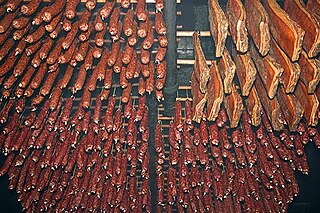
Smoking is the process of flavoring, browning, cooking, or preserving food, particularly meat, fish and tea, by exposing it to smoke from burning or smoldering material, most often wood.

A griddle, in the UK typically referred to simply as a frying pan or flat top, is a cooking device consisting mainly of a broad, usually flat cooking surface. Nowadays it can be either a movable metal pan- or plate-like utensil, a flat heated cooking surface built into a stove or kitchen range, or a compact cooking machine with its own heating system attached to an integrated griddle acting as a cooktop.

Cookware and bakeware is food preparation equipment, such as cooking pots, pans, baking sheets etc. used in kitchens. Cookware is used on a stove or range cooktop, while bakeware is used in an oven. Some utensils are considered both cookware and bakeware.

An oven is a tool that is used to expose materials to a hot environment. Ovens contain a hollow chamber and provide a means of heating the chamber in a controlled way. In use since antiquity, they have been used to accomplish a wide variety of tasks requiring controlled heating. Because they are used for a variety of purposes, there are many different types of ovens. These types differ depending on their intended purpose and based upon how they generate heat.

Water heating is a heat transfer process that uses an energy source to heat water above its initial temperature. Typical domestic uses of hot water include cooking, cleaning, bathing, and space heating. In industry, hot water and water heated to steam have many uses.
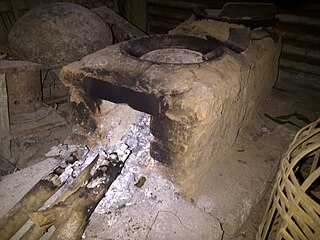
A stove or range is a device that generates heat inside or on top of the device, for local heating or cooking. Stoves can be powered with many fuels, such as electricity, natural gas, gasoline, wood, and coal.

A kitchen stove, often called simply a stove or a cooker, is a kitchen appliance designed for the purpose of cooking food. Kitchen stoves rely on the application of direct heat for the cooking process and may also contain an oven, used for baking. "Cookstoves" are heated by burning wood or charcoal; "gas stoves" are heated by gas; and "electric stoves" by electricity. A stove with a built-in cooktop is also called a range.
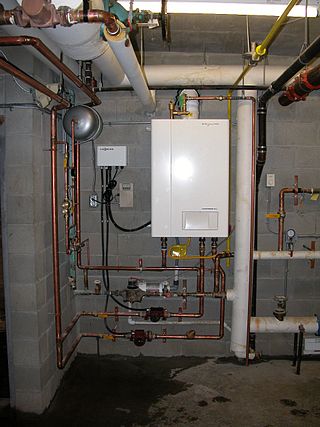
A central heating system provides warmth to a number of spaces within a building from one main source of heat. It is a component of heating, ventilation, and air conditioning systems, which can both cool and warm interior spaces.

A deep fryer is a kitchen appliance used to cook foods by full immersion in hot oil ”. The cooking oil are typically between temperatures of 350 to 375 °F.

A hot plate or hotplate is a portable self-contained tabletop small appliance cooktop that features one or more electric heating elements or gas burners. A hot plate can be used as a stand-alone appliance, but is often used as a substitute for one of the burners from an oven range or a kitchen stove. Hot plates are often used for food preparation, generally in locations where a full kitchen stove would not be convenient or practical. A hot plate can have a flat surface or round surface. Hot plates can be used for traveling or in areas without electricity.

Induction cooking is a cooking process using direct electrical induction heating of cooking vessels, rather than relying on indirect radiation, convection, or thermal conduction. Induction cooking allows high power and very rapid increases in temperature to be achieved: changes in heat settings are instantaneous.

A kotatsu is a low, wooden table frame covered by a futon, or heavy blanket, upon which a table top sits. Underneath is a heat source, formerly a charcoal brazier but now electric, often built into the table itself. Kotatsu are used almost exclusively in Japan, although similar devices for the same purpose of heating are used elsewhere, e.g. the Spanish brasero or Iranian korsi.
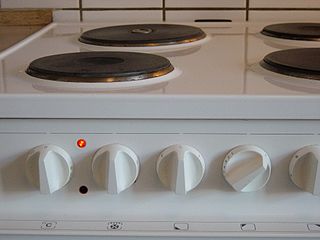
An electric stove, electric cooker or electric range is a stove with an integrated electrical heating device to cook and bake. Electric stoves became popular as replacements for solid-fuel stoves which required more labor to operate and maintain. Some modern stoves come in a unit with built-in extractor hoods.

A masonry heater is a device for warming an interior space through radiant heating, by capturing the heat from periodic burning of fuel, and then radiating the heat at a fairly constant temperature for a long period. Masonry heaters covered in tile are called Kachelofen. The technology has existed in different forms, from back into the Neoglacial and Neolithic periods. Archaeological digs have revealed excavations of ancient inhabitants utilizing hot smoke from fires in their subterranean dwellings, to radiate into the living spaces. These early forms eventually evolved into modern systems.
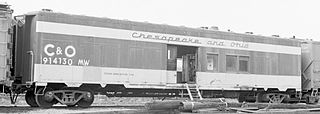
A steam generator is a type of boiler used to produce steam for climate control and potable water heating in railroad passenger cars. The output of a railroad steam generator is low pressure, saturated steam that is passed through a system of pipes and conduits throughout the length of the train.

A wood-burning stove is a heating or cooking appliance capable of burning wood fuel, often called solid fuel, and wood-derived biomass fuel, such as sawdust bricks. Generally the appliance consists of a solid metal closed firebox, often lined by fire brick, and one or more air controls. The first wood-burning stove was patented in Strasbourg in 1557. This was two centuries before the Industrial Revolution, so iron was still prohibitively expensive. The first wood-burning stoves were high-end consumer items and only gradually became used widely.

A storage water heater, or a hot water system (HWS), is a domestic water heating appliance that uses a hot water storage tank to maximize water heating capacity and provide instantaneous delivery of hot water. Conventional storage water heaters use a variety of fuels, including natural gas, propane, fuel oil, and electricity. Less conventional water heating technologies, such as heat pump water heaters and solar water heaters, can also be categorized as storage water heaters.



















